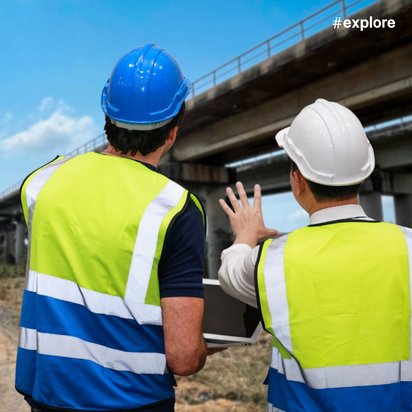Bridges under scrutiny
How the physical security of infrastructures is tested.

How the physical security of infrastructures is tested.

February 20, 2025
The partial collapse of the Carolabrücke in Dresden in autumn 2024 has fueled the discussion about the safety of bridges in Germany. How are bridges tested in this country? Are the measures sufficient? And what helps against the backlog of renovations?
Dresden, September 11, 2024: At 2:51 a.m., a Line 7 tram crosses the Carolabrücke, which connects Dresden’s Old Town with the New Town. 2:58 a.m.: A white delivery van drives over the roadway running parallel to the tram tracks. Suddenly: a deafening bang, a massive fountain of water shooting into the sky from the Elbe. A 100-meter-long section of the bridge, over which Line 7 had rolled just minutes earlier, crashes into the river.
The unexpected collapse sent a shockwave through the nation and left even experts stunned. On one hand, relief that, almost miraculously, no one was harmed; on the other, the question of how this could have happened.
This is an article from #explore. #explore is a digital journey of discovery into a world that is rapidly changing. Increasing connectivity, innovative technologies, and all-encompassing digitalization are creating new things and turning the familiar upside down. However, this also brings dangers and risks: #explore shows a safe path through the connected world.
The Carolabrücke, like every bridge in Germany, was inspected every six years in a comprehensive main inspection. During this process, structural engineers examine the entire bridge "up close," opening every manhole cover and inspecting even hard-to-reach components as closely as possible. The bridge is then graded, and further measures are planned based on the evaluation.
Between the main inspections, a simpler inspection takes place every three years, during which, for example, the roadway transitions and foundations are examined. Once a year, the bridge is checked for obvious damage and defects. "Given the low number of incidents with around 130,000 bridges in Germany, this cycle seems to be effective," said Dieter Westkamp, Head of Technology and Society at the Association of German Engineers, in an interview with Tagesschau. Manfred Curbach, Senior Professor at the Institute for Solid Construction at TU Dresden, also considers the inspection cycle and process to be sufficient. "Our German system is still one of the safest worldwide," says the bridge expert. "Above all, because in this country, unlike, for example, the Morandi Bridge in Genoa, serious defects are addressed immediately and without regard for economic consequences." For instance, when deformations were discovered at the Rahmede Valley Bridge in North Rhine-Westphalia on December 2, 2021, the bridge was closed on the same day—despite causing significant detours for tens of thousands of drivers and transport companies.
Why did the proven mechanisms fail in the case of the Carolabrücke? The last main inspection in 2023 identified a need for renovations but no immediate danger. Clarity was provided by the TU Dresden's report on the collapse in December 2024. According to the report, the main cause was so-called stress corrosion cracking, which began during the bridge's construction, as stated by expert Steffen Marx.
This phenomenon has been known for several decades and occurs with certain types of prestressing steel used in structures in both East and West Germany. After reunification, all affected structures were thoroughly investigated, and guidelines were issued on how to handle them. Some were subsequently demolished, others reinforced. The problem with the Carolabrücke: The wide cracks that typically indicate a deteriorated bridge did not appear beforehand. "The Carolabrücke is the very first case in which a bridge with this type of prestressing steel exhibited a completely different warning behavior," says Curbach.
According to expert Marx, the collapse of the bridge could not have been predicted using conventional methods. "The only way to detect such damage is by listening for it with an acoustic emission method," the specialist explained. Since late 2024, the remaining bridge sections A and B have been continuously monitored with such an acoustic emission system. This allows detection when prestressing steel in the bridge ruptures, further weakening its load-bearing capacity.
"The collapse of the Carolabrücke has heightened awareness of the issue, and that’s a good thing," says expert Curbach. As a result, 19 bridges of the same construction type in Saxony underwent special inspections and were equipped with monitoring systems. The Elbe bridge in Bad Schandau was closed as a consequence of this special inspection. It is now clear: a new construction is unavoidable, and this also applies to the remaining sections of the Carolabrücke.
Bridges with this specific type of prestressing steel are by no means the only problem cases among Germany’s bridges. Over half of the country’s bridges were built before 1985. Many are even older, approaching the end of their life cycle and needing replacement. Since many older bridges were not designed for today’s traffic conditions, their lifespan is further shortened by increased fatigue. A key issue is the rise in truck traffic. A single 40-ton truck stresses—and thus fatigues—a bridge as much as 30,000 passenger cars. When defects are detected, the affected bridge is often closed to trucks first to reduce the strain.
Federal Transport Minister Volker Wissing announced a package of measures for faster bridge renovations as early as 2022. Of the approximately 40,000 bridges under federal responsibility, 4,000 are to be prioritized for renovation within ten years. Instead of the previous 200, around 400 bridges are to be renovated annually, with funding increased to 2.5 billion euros per year starting in 2026.
However, in January 2024, the Federal Court of Auditors expressed strong doubts about whether this renovation schedule is actually feasible. "To renovate twice as many bridges, we also need twice the skilled personnel—and we simply don’t have that," says bridge expert Curbach. To achieve the set goal, entirely different and far more efficient methods are needed, "from the awarding of contracts to construction companies to the techniques used for bridge renovations."
One approach would be a stronger use of carbon concrete, in whose development Curbach and his colleagues in Dresden are significantly involved. In this process, mats or rods made of carbon fibers are inserted between the concrete layers. Carbon concrete is lighter, six times stronger and significantly more durable than steel concrete, since carbon unlike steel does not rust, explains Curbach the advantages. Not least, it can be installed faster, which accelerates renovation. A disadvantage: steel is currently still considerably cheaper than carbon. But since its corrosion resistance and higher strength also require less building material, it could match the total costs. 50 to 80 percent concrete could be saved compared to steel concrete. And less concrete is also better for the climate, after all, cement production is responsible for almost eight percent of global CO2 emissions.
The first small bridge made of carbon concrete has been spanning the Kuppritzer Water in Wurschen in the Bautzen district since 2021. Curbach and his team have also already used their innovative material to reinforce highway bridges in Hesse and Bavaria. The problem: All these construction projects require a so-called individual case approval, since carbon concrete is not yet standardly approved as a building material in Germany. Too often, the decision-makers in the authorities therefore give preference to the well-known procedures in bridge renovations, Curbach problematizes: We have done too little for too long and basically lived on wear and tear. We therefore need to become more innovation-friendly again, otherwise we won't manage this enormous task.

Manfred Curbach is a senior professor and former director of the Institute for Solid Construction at TU Dresden. With his team, he is significantly involved in the invention and development of carbon concrete.